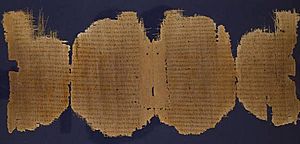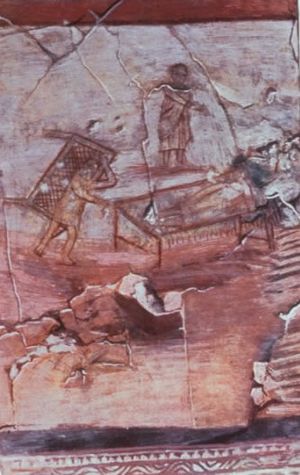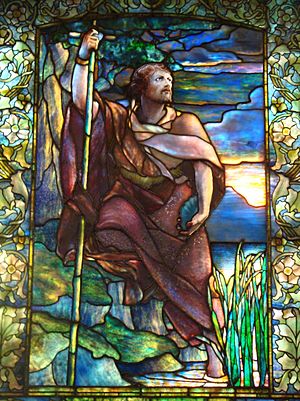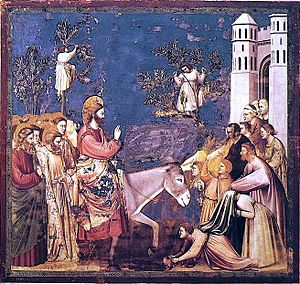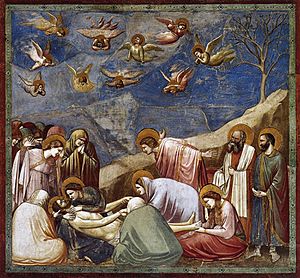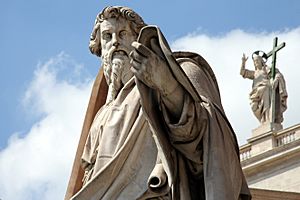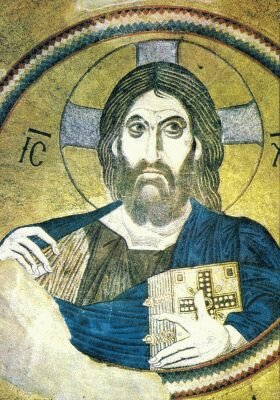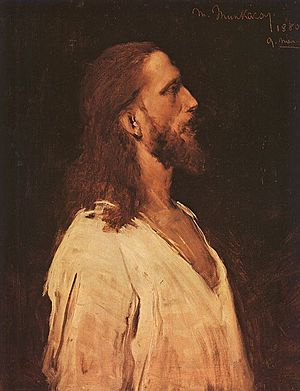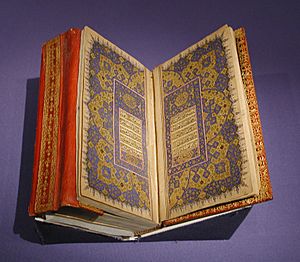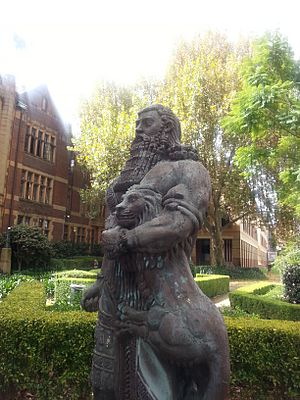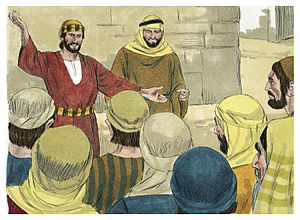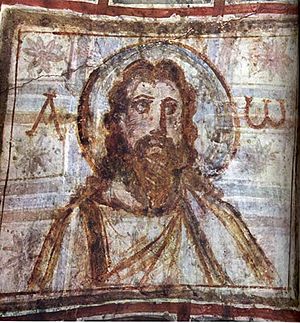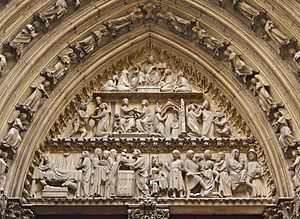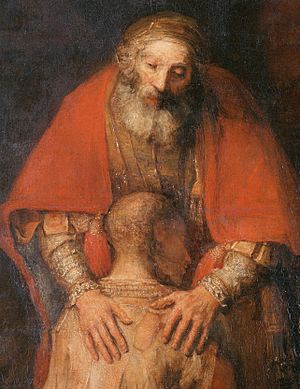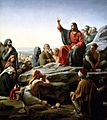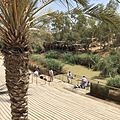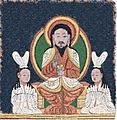Jesus facts for kids
Quick facts for kids
Jesus
|
|
|---|---|
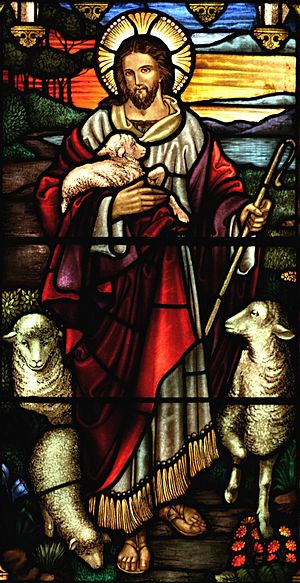 |
|
| Born | 6-4 BC |
| Died | 27 AD Judea, Roman Empire
|
| Cause of death | Crucifixion |
| Home town | Nazareth, Galilee |
| Parent(s) | |
Jesus of Nazareth, also known as Jesus Christ, was a Jewish teacher and religious reformer. He is the main figure in Christianity. Christians follow his example, believe his words, and worship him as the Jewish messiah and a form of God. He is one of the most famous and influential people in history.
Most historians agree that Jesus was a Jew from Nazareth in Judea, which is now part of Israel. They also agree that he was seen as a teacher and a healer. He was baptized by John the Baptist. Jesus was crucified in Jerusalem under the orders of Pontius Pilate. Christians believe he came back to life, or "rose again," three days later.
Jesus mostly taught about love and forgiveness for others. He also taught people to be humble about their religion. He often spoke about the "kingdom of God," saying it was "near." He taught that people should be gentle, like children, and never boast. He said God would forgive those who ignored Him and others, if they repented. Jesus disagreed with some Jewish priests who used religion to show off. This led to other Jewish leaders disliking Jesus. Jesus also challenged human authority, which led to his trial and execution by Roman authorities.
Stories about Jesus' life were written by different people. The most well-known are the four Christian books called the Gospels. They are the first part of the New Testament, which is in the Bible. The word "gospel" means "good news." These books tell a little about his birth and early life. But they mostly focus on his public life: his teachings, miracles, ministry, death, and resurrection (return from death).
Several Jewish and Roman historians, like Flavius Josephus, Tacitus, Pliny the Younger, and Suetonius, mention Jesus in their writings. They usually talk about his execution or problems between the Roman government and his followers. They do not talk much about his life itself.
Other religions also see Jesus as important. Manichaeans, Gnostics, Muslims, and Bahá'ís give Jesus a special place. The Quran says Jesus was a Muslim. Bahá'í teachings see Jesus as a "manifestation of God," which is their term for prophets. Some Hindus consider Jesus an avatar or a sadhu. Some Buddhists, including the 14th Dalai Lama, see Jesus as a bodhisattva. This means he dedicated his life to helping people.
Contents
Understanding Jesus' Name
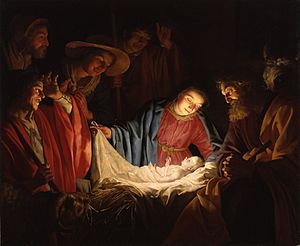
The name Jesus comes from the Aramaic name "Yeshua." This comes from the Hebrew Yah-shua, meaning "God is salvation" or "deliverance" in English. It was a common name at that time. Jesus is often called "Jesus Christ" or "Christ." The word Christ comes from the Greek word christos. It means "the one marked on the head with oil" or "the anointed one." In Jesus' time, anointing with oil showed that someone was chosen to be a king or leader. Jesus is also called Messiah, which comes from the Hebrew term Moshiach. This also means "the anointed one."
Jesus' Life in the Gospels
His Birth Story
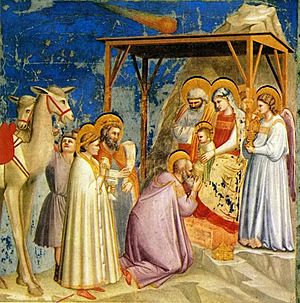
The Gospels of Matthew and Luke say that before Jesus was born, his mother Mary and her promised husband, Joseph, knew he would be the Messiah. This was the King promised to the Jewish people in their ancient books.
Luke's Gospel tells most of the story. When Jesus was born, the Roman Empire ruled much of the Middle East. The government wanted to count everyone for taxes. So, everyone had to return to their hometown. Joseph was from Bethlehem, near Jerusalem. Even though Mary was about to give birth, they had to travel there with many other people.
When they arrived in Bethlehem, all the rooms were full. Jesus was born and placed in a manger because there was no room at the inn. Shepherds watching their sheep nearby came to see the baby. They left singing thanks to God for the new king.
In Matthew's Gospel, it says that wise men from a faraway country saw a new star in the sky. They traveled to find the young Jesus. They knew the Messiah would be born under a star, and that this star meant Jesus was born to be a king.
Most Christians celebrate Jesus' birth on Christmas, December 25. The Gospels do not say the exact date Jesus was born. This date was chosen because there was already a Roman holiday on that day.
His Public Work
The arrival of Jesus was prophesied by John the Baptist. John baptized Jesus in the Jordan River. During the baptism, the Spirit of God, like a dove, came down on Jesus. The voice of God was also heard. The Bible says the Spirit led Jesus into the desert. There, he fasted for 40 days and resisted the Devil's temptations. Then Jesus went to Galilee, settled in Capernaum, and began to preach about the Kingdom of God. He was about 30 years old.
Jesus mainly taught by telling stories. He taught that God alone was the true king. He said people should love God and each other, as the scriptures taught. He also taught his followers how to pray. Jesus performed miracles that showed God's power. He gave hungry people food and wine, healed sick people, and brought dead people alive again. He also freed people from evil spirits.
Jesus chose twelve men, known as the Twelve Apostles. He trained them to share his message. He had many other followers, including women. However, due to Jewish customs, women followers could not travel far as teachers on their own.
The Bible says Jesus became famous. He went to Jerusalem, where many people were visiting for Passover. When they heard he was coming, they greeted him like a king. They thought he would free them from Roman rule. But Jesus rode into Jerusalem on a donkey, showing he came in peace.
Jesus did some things that upset the Jewish religious leaders. They felt he disrespected customs that Jews had kept for centuries. For example, Jews did no work on the 7th day of the week, the Sabbath, because it was a holy day. In John's Gospel, chapter 5, Jesus healed a crippled man. Jesus told the man to pick up his mattress and go home. Carrying the mattress on the Sabbath was against religious custom. So, the religious leaders argued with Jesus about it. They then watched everything he did.
In Mark's Gospel, chapter 11, it says that when Jesus arrived in Jerusalem, he went to the Jewish Temple. He became angry at what he saw. People were selling things and money lenders were cheating poor people. Jesus chased them away. He said the chief priests and scribes had turned the temple into a "den of thieves." They were making money from the poor and taking homes from poor women who had no other way to pay for temple worship.
His Death
The Gospels say that the temple leaders were angry and wanted to kill Jesus. They told the Roman government that Jesus' followers wanted him to become the king and take over the country. The Gospels say the Roman governor thought Jesus should be set free. But the Jewish leaders said, "If you do that, then you are not a friend of Caesar!" (Caesar was the Roman ruler.)
The Governor sentenced Jesus to death because his followers had called him king. Roman soldiers killed Jesus by crucifixion. He was nailed to a high cross by his hands and feet. This was a common way for the Romans to kill rebels and criminals.
Jesus' body was buried in a tomb belonging to one of his followers. On the day after the Sabbath, early in the morning, women went to treat the body with spice and perfumed oil. But the Gospels say Jesus' body was gone, and he was seen alive afterward. This is called the Resurrection.
Some people, like the disciple Thomas, said, "I won't believe this until I see it myself!" But the Bible says that over 500 people, including Thomas, saw Jesus alive again. The Gospels tell many stories about what Jesus did after he was resurrected. Finally, the Gospel of Luke says Jesus took his disciples to a hill. He blessed them and told them to spread his teaching throughout the world. Then clouds came down, and he was lifted up to Heaven.
Most Christians celebrate the time the Gospels say he died and was raised from the dead as the holiday of Easter.
Christian Beliefs About Jesus
The Christian Church is built on Jesus' teachings. What Christians believe about Jesus comes from the four Gospels in the Bible. It also comes from letters, or "Epistles," written in the 1st century. These letters explained Jesus' teachings to his followers.
Jesus did not write these letters. They were mainly written by a Jewish man named Paul. At first, Paul tried to stop Christianity from spreading. Then he became a Christian himself and was an important leader. As Christian churches started in different towns, Paul wrote letters to them. Many Christian beliefs are found in Paul's letters. They also give instructions for running churches and families.
Other letters in the New Testament were written by Peter, James, and John. These letters help form the beliefs modern Christians have.
Jesus as God
Whether Jesus is God has been debated for a long time. Most Christians, including Catholics, Orthodox, and Protestants, believe Jesus was both God and human. The New Testament describes Jesus as "the Word of God," "the Son of God," "the Son of Man," and God himself.
These teachings are believed by most Christians but not by many other people. Islamic teaching says Jesus was a prophet, but not part of God or "the Son of God." Islam is strictly monotheistic, meaning there is only one God. Muslims believe Jesus cannot be part of God because there is only one God. Worshiping someone other than God is seen as polytheism (belief in more than one god) or idolatry.
In Jesus' own time, many Jews became very angry when Jesus said he was the "Son of God." Most Jews do not believe this.
These Bible verses show the Christian teaching that Jesus is God:
- "In the beginning was the Word, and the Word was with God and the Word was God. He was in the beginning with God." John 1:1-3, ESV
- "The Word became a human being. He made his home with us. We have seen his glory. It is the glory of the one and only Son. He came from the Father. And he was full of grace and truth." John 1:14, NIRV
- "Jesus said...'I and the Father are one.'" John 10:30, ESV
- "Christ is God over all, blessed forever." Romans 9:5, ESV
- "[We are] waiting for our blessed hope, the appearing of the glory of our great God and Savior Jesus Christ." Titus 2:13, ESV
- "In [Jesus] the fullness of the deity dwells bodily." Colossians 2:9, ESV
Jesus is also called "the Son of God."
- "And the Word became flesh and dwelt among us, and we have seen his glory, glory as of the only Son from the Father, full of grace and truth." John 1:14, ESV
- "In these last days he has spoken to us by his Son, whom he appointed the heir of all things, through whom also he created the world. He is the radiance of the glory of God and the exact imprint of his nature, and he upholds the universe by the word of his power." Hebrews 1:2-3, ESV
- "And we know that the Son of God has come and has given us understanding, so that we may know him who is true; and we are in him who is true, in his Son Jesus Christ. He is the true God and eternal life." 1 John 5:20, ESV. This letter is thought to be by the same John who wrote John's Gospel.
All Christians believe these verses mean Jesus is God. All Christians believe Jesus' death on the cross allows all people to be forgiven by God for their sins (bad things they have done). Most Christians believe that if a person asks God for forgiveness, He will grant it, and they will live forever with Him in Heaven.
God in Human Form
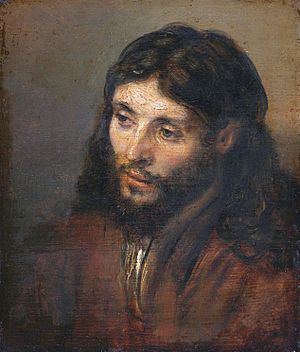
Christians believe that, according to the Bible, Jesus was truly God and truly human. They believe this was part of God's plan to help humans understand Him better. People who do not have Christian beliefs have different ideas about Jesus.
A verse from the Bible says:
- "...and the Word became flesh and dwelt among us." John, 1:14
In Matthew's Gospel, Jesus is often called "the Son of Man." Matthew uses these words from the Old Testament. There, they often show that humankind is very different from God. In the Bible, God is often praised for helping ordinary humans, who are called "the sons of man." In Psalm 8, King David asks God, "What is man and the son of man, that you should care so much and give him such wonderful power over the Earth and all its creatures?"
In Matthew's Gospel, 24:30, Jesus says, "..They shall see the Son of Man coming in the clouds of Heaven with power and great glory." Like King David in Psalm 8, Jesus shows a difference between his ordinary human life and his great power as the Son of God.
"The Good Shepherd"
One of the most loved parts of the Old Testament is Psalm 23. It starts:
- "The Lord is my shepherd; then I will not want anything more. He leads me by still water and in green fields."
In the Gospels, Jesus often spoke about himself as being like a shepherd caring for sheep. He called himself the "Good Shepherd" who would even give his life to protect his sheep. He told the Jewish people that he had "other sheep" (referring to non-Jewish believers) that did not belong to this flock (John, 21:16). In one of his last talks with his disciple Peter, he told him, "Feed my sheep!" This meant, "Take care of my people."
"The Holy Saviour"
In Judaism, from ancient times, people were seen as sinful or bad. They needed God's forgiveness. They believed there were two ways to get God's forgiveness: by prayer and by sacrifice. Prayer could be done anywhere, but sacrifices were done at the temple. A person would bring an animal, often a lamb, or a dove if they were poor. They would put their hands on the animal to place their sins on it. Then the animal would be killed as punishment for the sin. This type of sacrifice continued until the temple in Jerusalem was destroyed in 71 AD. Paying money to the temple was also a kind of sacrifice. When Jesus drove the traders out of the temple, they were the ones who sold lambs and doves, and exchanged Roman money for special temple money.
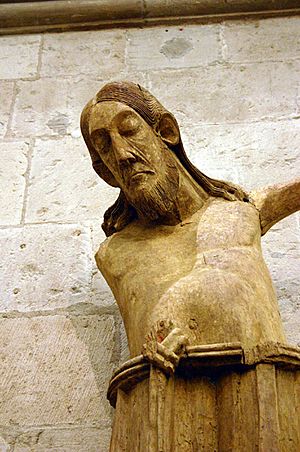
Part of Christian belief is that Jesus Christ did not just come as a human to teach a better way of life. Christians also believe that Jesus was the ultimate sacrifice for the sin of humankind. Jesus is the "Saviour": the one who saves. Christians believe that, unlike ordinary people, Jesus was completely pure and free from sin. But when he died on the cross, he took on himself all the sins of every person who would believe in him, like the lamb sacrificed in the temple.
Based on John's Gospel, Christian teaching is that Jesus' death and resurrection show his power to forgive the sins of anyone who turns to him and truly asks for forgiveness. The Bible says that forgiven sinners should try to live a new life and not return to their sinful behavior. Christians believe that knowing about God's love helps people live a new and better life.
These three verses from the Bible are important in this Christian belief:
- "God loved the world so much that he gave his only Son, so that, whoever believes might not die but have eternal life."' John's Gospel, 3:16.
- Jesus said: "I am the way, the truth and the life. If anyone comes to the Father, they must come by me!" John's Gospel, 14:6.
- "If we say we have no sins, we are fooling ourselves and not telling the truth. But if we tell our sins humbly to God, then He has promised to listen and to forgive our sins and make us clean from all our badness." from the First Letter of John.
Other Views About Jesus
Jesus as a Teacher
Some people who are not Christians believe that Jesus lived when the Gospels say he did. However, they do not believe he was the "Son of God" or "Saviour." They believe Jesus was an ordinary but very good person, a teacher, and perhaps a prophet.
Mohandas Gandhi said, "I am a Muslim, and a Hindu, and a Christian, and a Jew," even though he was born a Jain.
Muslim Beliefs About Jesus
Muslims believe Jesus (called Isa) was the second-to-last Prophet (messenger of God). They believe that Muhammad was the very last Prophet. They believe both Jesus and Muhammad were ordinary men, chosen by God to serve Him and teach the word of Islam.
Muslims do not believe Jesus was God or "the Son of God." Islam is strictly monotheistic: it says there is only one God. Muslims believe Jesus cannot be part of God because there is only one God. If someone other than God is worshiped, it is seen as polytheism (belief in more than one god) or idolizing someone other than God.
Islam teaches that Jesus did not die on the cross. Instead, another man disguised as him went on the cross.
Muslims also accept some other teachings about Jesus. These teachings say that Jesus will return to Earth in the End Of Days. He will then destroy the false messiah or Anti-christ before the day of judgment. Muslims also accept Jesus' claims to be a healer. They believe in the many miracles he is said to have performed, like raising the dead and giving sight to the blind. They believe all his miracles were granted to him by God.
The Qur'an (like the Bible) mentions the virgin birth of Jesus. But it says other things about Mary (Islamic-Maryam). The Bible says Joseph helped Mary give birth to Jesus. In Islam, there is no Joseph. Instead, Mary walked the desert alone in labor and found a tree. The angel Gabriel (Jibreel) asked if she was hungry. Then he told her to shake the tree, and dates fell for her to eat. Then he asked if she was thirsty. He said to look down at her feet, and there was water. There she gave birth to Jesus. This is why Muslims fast and how they break their fast.
Jewish Beliefs About Jesus
Even though Jesus was a Jew and his teaching came from the Jewish religion, most Jewish people do not believe Jesus was the Messiah promised in the Jewish Scriptures.
The Gospels say that Jesus made the Jewish teachers very angry with his teachings. Part of their anger was because he called them "hypocrites." This means they acted holy on the outside, but their hearts were far from God.
In the Gospels, another reason for their anger was that Jesus acted as if he was the Messiah and said he was the "Son of God." This meant he was either a terrible liar, or he was mentally unwell and just imagined it, or it was true. But Jesus did not seem unwell. So that left only two choices. If Jesus was lying, he was doing something very wrong against the Jewish religion. Because Jesus claimed to be the "Son of God," some Jewish leaders wanted him killed. They handed him over to the Roman rulers. The Romans did not care if Jesus said something against Jewish beliefs. But they knew people had also called Jesus "King of the Jews." The Jewish leaders claimed this went against Roman government laws. Although the Roman leaders did not fully agree, they had him killed to prevent a possible riot.
Today and throughout history, most Jews do not believe what Christians say about Jesus. However, some Jews do believe Jesus was the Messiah promised in the Jewish Scriptures. Jews who believe this are called "Messianic Jews".
Jesus as a Myth
Some writers have suggested that Jesus might never have existed. They propose that the Gospel stories about Jesus are just a good story or myth. Most historians disagree with this view.
Jesus and Old Traditions
Other writers have argued that parts of Jesus' story are similar to stories from other religions, like those of Gilgamesh and Mithras. They also claim that Christianity's main Holy Days happen at times when there were already Roman or Jewish festivals, such as Easter at the time of Passover.
How the Gospels Were Written
In the late 20th and 21st centuries, almost all scholars, both Christian and non-Christian, agree that Jesus was a real person. Both Christian and non-Christian scholars base their studies on the Gospels. These are believed to have been written between 60-90 AD.
Traditionally, the Gospels were written by four men: Matthew, Mark, Luke, and John. These books are named after them.
This is the order they appear in the New Testament of the Bible. However, scholars think this is not the order they were written. The Gospel of Mark was likely written before the Gospel of Matthew. The four Gospels all tell Jesus' life story, but from four different viewpoints. This is because different people wrote them, and each writer had reasons to tell the story in a different way.
Other scholars have said that leaders in the Early Christian Church made changes to the Gospel writings. These changes are said to have happened at different times, in different ways, and for different reasons.
About Mark's Gospel
Mark's Gospel is thought by Bible scholars to be the earliest. It is named after a young follower of the apostle Paul, who is mentioned several times in the "Acts of the Apostles" and Paul's Letters. The Gospel was probably written in Rome. Scholars believe it comes from the memories of Jesus' follower, Peter. It does not tell about Jesus' birth. It starts when he was 30 years old, when his followers first met him. It shows Jesus as a man of action: traveling, teaching, and healing people.
About Matthew's Gospel
Matthew's Gospel was written next. Matthew was one of Jesus' followers. He was a Jewish man disliked by other Jews because he worked for the Roman rulers as a tax collector. Matthew tells that one day Jesus saw him at his desk in the market place and said, "Follow me." Most Bible scholars believe Matthew had read Mark's Gospel. He decided to add things Mark left out. Mark wrote for the Church of Rome, but Matthew wanted to write for Jewish Christians across the Roman Empire. Matthew was a well-educated Jew, so he knew the Jewish Scriptures (which Christians call the Old Testament). Matthew knew the scriptures taught that the Messiah, or God's chosen one, would come. In his Gospel, he often mentions these teachings. He also starts by listing Jesus' ancestors, which was important to Jewish readers.
About Luke's Gospel
The apostle Luke was Greek and a friend of the apostle Paul. He was a doctor. Luke learned about Jesus from the disciples. Luke writes about Jesus' birth and childhood. He says, "Mary kept all these things in her heart and thought about them." Luke was not a Jew. He writes in a way that is easy for non-Jews to understand. He explains Jewish customs and laws. He wrote a second book called the Acts of the Apostles, which tells what the disciples did after Jesus left them.
About John's Gospel
Bible scholars believe John was a disciple of Jesus. He was probably the youngest of the twelve main followers. He lived to be an old man. Because of his teaching about Jesus, he was sent to a small island called Patmos. John writes with one main idea. He wants to prove to the reader that Jesus is God's way of saving humans from the terrible problem of sin or evil. John starts by telling the reader that Jesus was (and is) God. John says that Jesus is God's Living Communication (or Living Word). Every part of John's Gospel shows that Jesus came from God, taught the Message of God, and is the way for people to understand God's Love.
Teaching with Stories (Parables)
The Gospels tell many stories Jesus used to teach people about God's love and how they should live. These are called parables. Here are some examples:
The Good Samaritan
In this story from chapter 10 of Luke's Gospel, Jesus shows what it means to be a good neighbor. Near the Jews lived people called Samaritans. They disagreed about religious teachings and were considered enemies. One day, a Jewish man was walking when robbers beat him, robbed him, and left him almost dead by the road. A Jewish priest came along and saw him. He thought, "If I touch that man, I will be unclean and cannot go to the Temple!" So he pretended not to see him. Another Jew, a Holy Man, came along and did the same. At last, a Samaritan came along with a donkey. When he saw the wounded man, he stopped. He washed his wounds with wine and olive oil. Then he put him on his donkey and took him to the nearest inn. He paid the innkeeper and said, "Keep him until he is well. Whatever more is needed, I will pay when I return." Jesus asked the people listening, "Which one of these people acted like a good neighbor?" They said, "He that stopped and helped." Jesus said, "You go and do the same."
The Prodigal Son
In this story from chapter 15 of Luke's Gospel, Jesus tells how a rich man had two sons. They would both get a share of his money when he died. The younger son said, "Father, give me my money now, so I can go and enjoy myself while I'm young." He took the money to the city and spent it all on parties with his friends. Soon he had no money left to feed himself. He was ashamed. He got a job caring for pigs, but he was almost starving. He said to himself, "I'll go home to my father and say, 'Father, I have sinned! Please let me be a servant in your house!'" When his father saw him coming, he ran to him and hugged him. The father said, "Bring the finest clothes! Kill the fattest calf to make a feast!" When the older brother heard all this, he was angry. He said, "I'm a good son to you, but you never even gave me one little goat to have a party with my friends!" The father said, "You have always been with me. I love you greatly, and all I have is yours. But my son who was lost is now found! My son who seemed to be dead is alive! Be happy with me!" Jesus said that this is how God loves and forgives his people when they ask for forgiveness.
Other Pages to Explore
Images for kids
-
The Finding of the Saviour in the Temple, by William Holman Hunt, 1860
-
The Baptism of Christ by John the Baptist, by José Ferraz de Almeida Júnior, 1895
-
Sermon on the Mount, by Carl Bloch, 1877, depicts Jesus' important discourse
-
The Exhortation to the Apostles, by James Tissot, portrays Jesus talking to his 12 disciples
-
The Return of the Prodigal Son by Pompeo Batoni depicts the Parable of the Prodigal Son. Jesus told many parables during his ministry.
-
Jesus cleansing a leper, medieval mosaic from the Monreale Cathedral, late 12th to mid-13th centuries
-
The Transfiguration of Jesus, depicted by Carl Bloch, 19th century
-
A painting of Jesus' final entry into Jerusalem, by Jean-Léon Gérôme, 1897
-
The Last Supper, depicted by Juan de Juanes, c. 1562
-
A depiction of the kiss of Judas and arrest of Jesus, by Caravaggio, c. 1602
-
Ecce homo! Antonio Ciseri's 1871 depiction of Pontius Pilate presenting Jesus to the public
-
Pietro Perugino's depiction of the Crucifixion as Stabat Mater, 1482
-
Appearance of Jesus Christ to Maria Magdalena by Alexander Andreyevich Ivanov, 1835
-
The name Jesus son of Mary written in Islamic calligraphy followed by Peace be upon him
-
The Druze maqam of Al-masih (Jesus) in As-Suwayda Governorate.
-
Jesus depicted as the liberator of Black slaves, on the masthead of the Abolitionist paper "The Liberator"
-
Enthroned Jesus image on a Manichaean temple banner from c. 10th-century Qocho
-
The Shroud of Turin, Italy, is the best-known claimed relic of Jesus and one of the most studied artifacts in human history.
See also
 In Spanish: Jesús de Nazaret para niños
In Spanish: Jesús de Nazaret para niños


